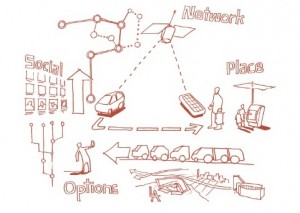 “The underlying concept of cloud computing dates back to 1960s, when John McCarthy opined that “computation may someday be organized as a public utility“. Almost all the modern day characteristics of cloud computing (elastic provision, provided as a utility, online, illusion of infinite supply), the comparison to the electricity industry and the use of public, private, government and community forms was thoroughly explored in Douglas Parkhill’s, 1966 book, “The Challenge of the Computer Utility”.†(taken from Wikipedia)
“The underlying concept of cloud computing dates back to 1960s, when John McCarthy opined that “computation may someday be organized as a public utility“. Almost all the modern day characteristics of cloud computing (elastic provision, provided as a utility, online, illusion of infinite supply), the comparison to the electricity industry and the use of public, private, government and community forms was thoroughly explored in Douglas Parkhill’s, 1966 book, “The Challenge of the Computer Utility”.†(taken from Wikipedia)
“Cloud computing is a general term for anything that involves delivering hosted services over the Internet. These services are broadly divided into three categories: Infrastructure-as-a-Service (IaaS), Platform-as-a-Service (PaaS) and Software-as-a-Service (SaaS). The name cloud computing was inspired by the cloud symbol that’s often used to represent the Internet in flowcharts and diagrams.
A cloud service has three distinct characteristics that differentiate it from traditional hosting. It is sold on demand, typically by the minute or the hour; it is elastic — a user can have as much or as little of a service as they want at any given time; and the service is fully managed by the provider (the consumer needs nothing but a personal computer and Internet access). Significant innovations in virtualization and distributed computing, as well as improved access to high-speed Internet and a weak economy, have accelerated interest in cloud computing.
A cloud can be private or public. A public cloud sells services to anyone on the Internet. A private cloud is a proprietary network or a data center that supplies hosted services to a limited number of people. When a service provider uses public cloud resources to create their private cloud, the result is called a virtual private cloud. Private or public, the goal of cloud computing is to provide easy, scalable access to computing resources and IT services.†(taken from SearchCloudComputing.com)
What if we were to look at our means of personal transport within a metropolitan area in a similar way to how we are beginning to deal with our personal computing and access to the digital realm? Just as we have “cloud computing†shouldn’t we begin to look at “cloud mobility� What do we mean by that?
More and more we are surrendering the storage and access to very personal information (financial, health, family & social preference) to servers over which we have little or no personal control. Where once we were satisfied to keep our personal records in a file cabinet at home (or as often as not in a cardboard box), we gradually shifted to storing that information on our own personal computer, until now many are comfortable in having this information stored on a remotely located server to which we have access through portable wireless devices. Many of us have surrendered the need to physically hold onto our most personal information, to a situation where we are comfortable with having such information stored elsewhere (we don’t know and for the most part don’t care where) so long as we know (or hope) that it is securely held and is available, in digital form through the use of portable wireless devices, for our own use at any time of our choosing.
If we are willing to surrender the need to have such personal information close by in a physical form, is it not unreasonable that we could just as easily surrender the need to have our private “mobility device†(i.e. our car, along with its related maintenance, registration and insurance costs) if we know that we can have access to such a “mobility device†(perhaps a Redcar) through the use of a portable wireless device, for our own (or shared) use at any time of our choosing? What if we think of such a system as being analogous to the cloud computing described above? The “Redcar†system, perhaps “organized as a public utilityâ€, would have the “Infrastructure-as-a-Service†(AHS, Autonomous Vehicle Guidance etc.), the “Platform-as-a-Service†(the non-fossil fuel Redcar type vehicle or an adapted symbiote) and the “Software-as-a-Service†(the Redcar apps). A model for our system exists, the hardware and software exists, the technology exists and with society’s willingness to surrender the need for “hard copies†of personal material (and by extension the privately owned car) surely we are at a point where we can start connecting the dots to create a ubiquitous, accessible and sustainable mobility system that can adapt the existing hard infrastructure that society has already spent time and treasure in creating.
Just another thought.

